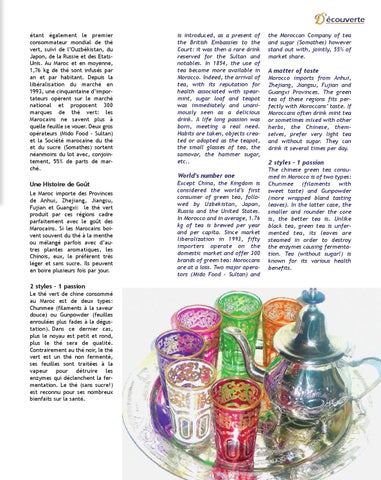écouverte étant également le premier consommateur mondial de thé vert, suivi de l’Ouzbékistan, du Japon, de la Russie et des EtatsUnis. Au Maroc et en moyenne, 1,76 kg de thé sont infusés par an et par habitant. Depuis la libéralisation du marché en 1993, une cinquantaine d’importateurs opèrent sur le marché national et proposent 300 marques de thé vert: les Marocains ne savent plus à quelle feuille se vouer. Deux gros opérateurs (Mido Food - Sultan) et la Société marocaine du thé et du sucre (Somathes) sortent néanmoins du lot avec, conjointement, 55% de parts de marché.
is introduced, as a present of the British Embassies to the Court: it was then a rare drink reserved for the Sultan and notables. In 1854, the use of tea became more available in Morocco. Indeed, the arrival of tea, with its reputation for health associated with spearmint, sugar loaf and teapot was immediately and unanimously seen as a delicious drink. A life long passion was born, meeting a real need. Habits are taken, objects created or adopted as the teapot, the small glasses of tea, the samovar, the hammer sugar, etc..
World’s number one Une Histoire de Goût Le Maroc importe des Provinces de Anhui, Zhejiang, Jiangsu, Fujian et Guangxi: le thé vert produit par ces régions cadre parfaitement avec le goût des Marocains. Si les Marocains boivent souvent du thé à la menthe ou mélangé parfois avec d’autres plantes aromatiques, les Chinois, eux, le préfèrent très léger et sans sucre. Ils peuvent en boire plusieurs fois par jour.
2 styles - 1 passion Le thé vert de chine consommé au Maroc est de deux types: Chunmee (filaments à la saveur douce) ou Gunpowder (feuilles enroulées plus fades à la dégustation). Dans ce dernier cas, plus le noyau est petit et rond, plus le thé sera de qualité. Contrairement au thé noir, le thé vert est un thé non fermenté, ses feuilles sont traitées à la vapeur pour détruire les enzymes qui déclenchent la fermentation. Le thé (sans sucre!) est reconnu pour ses nombreux bienfaits sur la santé.
Except China, the Kingdom is considered the world’s first consumer of green tea, followed by Uzbekistan, Japan, Russia and the United States. In Morocco and in average, 1.76 kg of tea is brewed per year and per capita. Since market liberalization in 1993, fifty importers operate on the domestic market and offer 300 brands of green tea: Moroccans are at a loss. Two major operators (Mido Food - Sultan) and
the Moroccan Company of tea and sugar (Somathes) however stand out with, jointly, 55% of market share.
A matter of taste Morocco imports from Anhui, Zhejiang, Jiangsu, Fujian and Guangxi Provinces. The green tea of these regions fits perfectly with Moroccans’ taste. If Moroccans often drink mint tea or sometimes mixed with other herbs, the Chinese, themselves, prefer very light tea and without sugar. They can drink it several times per day.
2 styles - 1 passion The chinese green tea consumed in Morocco is of two types: Chunmee (filaments with sweet taste) and Gunpowder (more wrapped bland tasting leaves). In the latter case, the smaller and rounder the core is, the better tea is. Unlike black tea, green tea is unfermented tea, its leaves are steamed in order to destroy the enzymes causing fermentation. Tea (without sugar!) is known for its various health benefits.
